What was your least-liked vegetable as a child?
We’re guessing the beet, but now, as an enlightened, health- and weight-conscious adult, you’ve come to embrace this ungainly root vegetable with so many benefits.
- Beets are low in calories but rich in essential vitamins and minerals.
- They’re rich in nitrates, which can enhance stamina and endurance.
- They’re packed with antioxidants, which protect cells from damage and reduce inflammation.
- Their high potassium content supports flexible blood vessels and reduces the risk of high blood pressure and heart disease.
- Their high fiber content promotes digestive health and regularity.
Plus, they’re delicious in dishes like balsamic roasted beets, hummus, fries, and salads! And pickles, of course!
The wild ancestor of the beet grew along the coasts of Europe, North Africa, and the Mediterranean. They were first cultivated for their greens, not their taproots.
They’re easy to grow in Southern California’s mostly balmy conditions, and their hardiness helps them survive even inexperienced gardeners.
Here’s how to grow beets in your family garden:
Choosing a Variety
Beets, scientifically known as Beta vulgaris, are root vegetables in various shapes and sizes, from round to cylindrical, and in hues ranging from deep red to golden yellow.
- Detroit Dark Red: This classic variety produces round, deep red roots with sweet, tender flesh. It stores exceptionally well and can be harvested at different stages, from baby beets to full maturity.
- Golden Beet: Distinguished by its vibrant golden-yellow color, it has a mild, sweet flavor and is less earthy than red beets. It has the added benefit of not bleeding color when cooked.
- Chioggia: Also known as “Candy Stripe” beets, Chioggia beets are easily identifiable by their unique concentric rings of white and pink when sliced. They have a sweet, mild flavor and are particularly popular in salads. Chioggia beets perform well in Southern California’s climate and can be a fun, colorful addition to your garden.
- Cylindra: This dark red variety grows cylindrical (surprise!), making it a candidate for uniform slicing. Cylindra beets have exceptional flavor and smooth, tender flesh.
- Avalanche: Avalanche beets are a white variety with a mild and sweet flavor. They don’t have the earthy taste of red beets, making them a favorite among beet-lovers with sensitive palates.
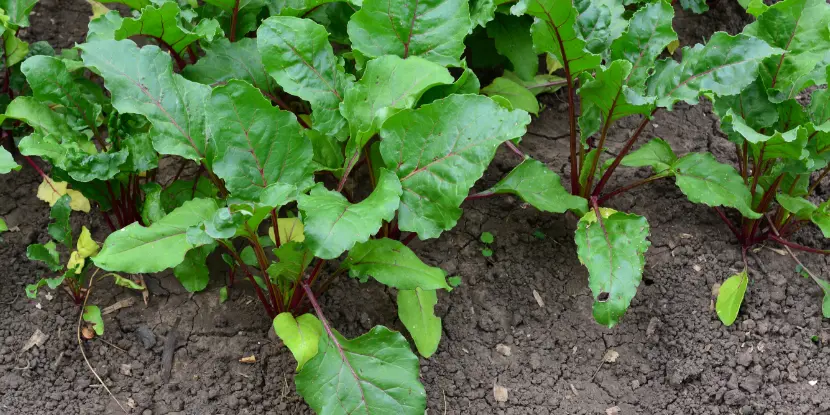
Beets were first cultivated for their greens and not the roots.
Planting Beets
When to Plant
Beets are cool-season vegetables that thrive in temperatures between 50°F and 75°F. In most regions, the ideal time to plant them is early spring or late summer. However, they tolerate light frosts, making them suitable for fall and winter cultivation in milder climates.
Choosing a Location
Beets prefer full sun exposure and well-drained soil. They’re not fussy about soil pH, but it should be between 6.0 and 7.5 for best results.
Preparing the Soil
- Clear the planting area of any rocks, sticks, and weeds.
- Use a garden fork or tiller to loosen the soil to a depth of 12 to 15 inches. This promotes root penetration.
- Mix in organic matter like compost or well-rotted manure to enhance soil fertility.
- Test the soil and, if necessary, adjust the pH to fall between 6.0 and 7.5. Lime will raise the pH, and sulfur will lower it.
- Incorporate a balanced, slow-release fertilizer into the top few inches of soil. Avoid excessive nitrogen, which can lead to leafy growth at the expense of root size.
- Form rows or raised beds for planting. Space the rows about 12 to 18 inches apart.
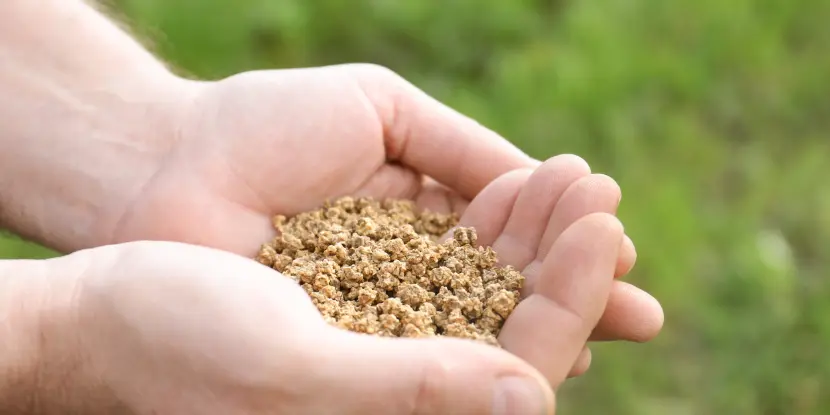
Beets are easiest to grow from seeds planted directly in the garden.
Planting Seeds
Beets don’t transplant well. Sow your beet seeds directly into the garden bed.
- Before planting, water the soil thoroughly.
- Sow seeds 1/2 inch deep and 1 inch apart in rows spaced 12 inches apart.
- Cover with a thin layer of soil and water gently.
- Keep the soil consistently moist as the seeds germinate.
Thinning the Seedings
- Beet seedlings emerge within 5 to 10 days, depending on soil temperature and moisture levels.
- Once the seedlings reach about 2 inches high, thin them to stand 3 to 4 inches apart.
- This spacing gives each beetroot room to develop.
- For a continuous harvest, sow seeds every 2 to 3 weeks until temperatures become too warm or too cool for optimal growth.
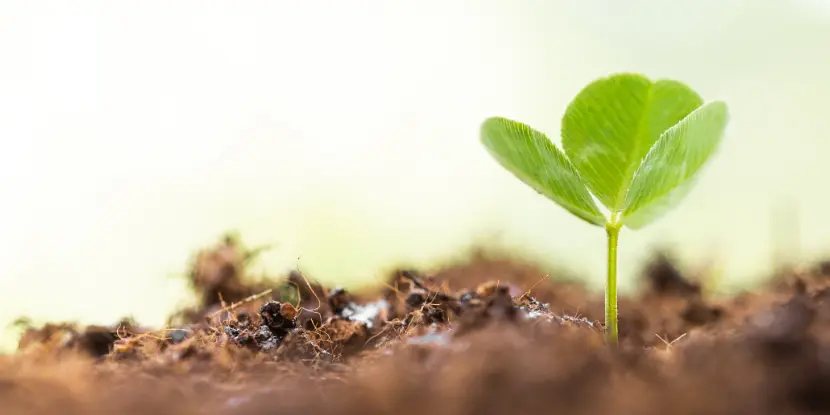
A beet seedling usually appears 7 – 14 days after planting a seed.
Caring for Your Beets
Watering
- Keep the soil moist but not soggy. Beets need about 1 inch of water per week from rainfall or irrigation.
- Water deeply once or twice a week, rather than frequent shallow watering. This encourages deep root growth.
- Apply a layer of mulch around the beet plants to retain soil moisture, reduce evaporation, and keep the soil cool.
- Water your beets in the morning to allow the foliage to dry by evening.
- Maintain a steady supply of water, especially during dry spells. Inconsistent watering can cause woodiness or splitting.
- Regularly check soil moisture by inserting your finger into the soil 2 inches deep. Water if the soil feels dry at this depth.
- Consider using drip irrigation or soaker hoses to deliver moisture directly to the root zone.
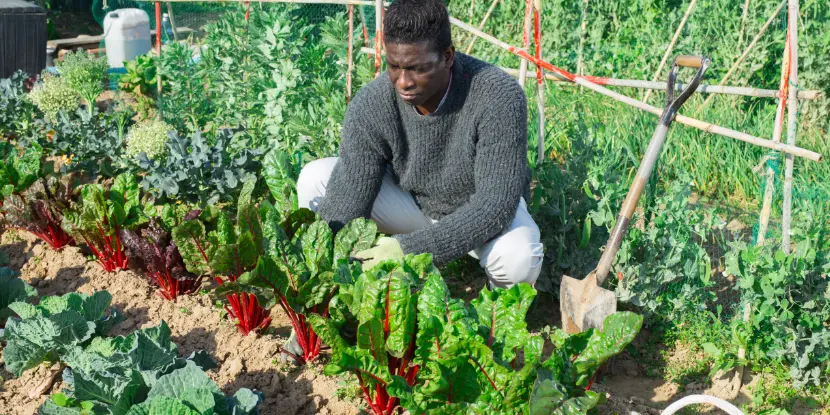
A gardener tends to his healthy beet plants.
Fertilizing
- At planting time, incorporate a balanced, slow-release fertilizer into the soil. Aim for a formula like 10-10-10 (nitrogen-phosphorus-potassium).
- A month after seedlings emerge, apply a side-dressing of compost or organic fertilizer. Sprinkle it alongside the rows, avoiding contact with the plants.
- Beets need adequate nitrogen for leafy growth, but too much nitrogen can inhibit root development. Lightly applying a nitrogen-rich fertilizer can help if leaves are pale or yellowing.
- Every 4-6 weeks, provide additional nutrients by side-dressing with composted manure or an all-purpose vegetable fertilizer.
- If your soil is nutrient deficient or your plants show signs of stress, apply liquid seaweed or fish emulsion as a foliar spray.
- Over-fertilizing can cause salt buildup in the soil. Stick to recommended amounts for each type of fertilizer you use.
Managing Pests & Diseases
Pests
Beets are relatively resistant to pests but watch for aphids, flea beetles, and leaf miners.
- Look for specific damaged leaves, discoloration, or small insects.
- For minor infestations, physically remove pests by hand.
- Use a strong stream of water to dislodge insects like aphids.
- Introduce natural predators, like ladybugs for aphids or parasitic wasps for leaf miners. Plant companion plants that attract beneficial insects.
- Apply neem oil, insecticidal soap, or diatomaceous earth according to the product instructions.
- Rotate crops to prevent the pest buildup in the soil.
- Maintain good garden hygiene by removing debris and weeds that can harbor pests.
- Deploy floating row covers to create a physical barrier against insects like flea beetles.
- Companion planting with aromatic herbs like basil and cilantro can deter pests.
Diseases
Common beet diseases include leaf spots, downy mildew, and root rot.
- Look for symptoms like yellowing leaves, stunted growth, or spots.
- Remove and destroy any severely infected plants to prevent the spread of disease. Never compost diseased plants.
- Rotate your beet crop with unrelated plants each year to prevent soil-borne diseases from building up.
- Proper spacing between plants enhances air circulation and reduces the risk of fungal diseases.
- Avoid planting too close to other plants or in shaded, damp areas.
- Clean up plant debris, weeds, and other garden residues regularly.
- Sanitize gardening tools and equipment between uses.
- Water the base of the plants rather than the foliage to avoid creating humid conditions that favor disease.
- Diluted neem oil or garlic spray can suppress fungal infections.
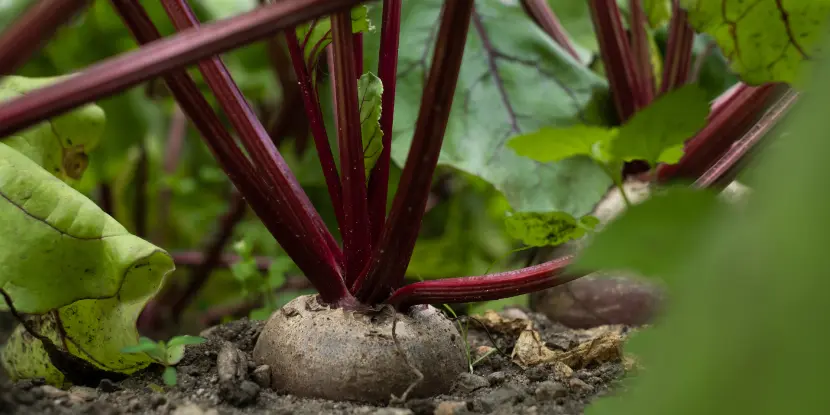
A beet plant ready for harvest.
Harvesting & Storage
Beets are ready for harvest when they reach 1 to 3 inches in diameter. Don’t let them grow too long; oversized beets can be tough and fibrous. Harvest them promptly once they mature for optimal flavor and texture.
How to harvest beets
- Gently loosen the soil around the base of the plant and grasp the foliage near the root.
- Carefully pull upward, taking care not to damage the beet itself.
- Trim off the leaves, leaving about an inch of stem attached to the root. BTW, the fresh leaves make for a tasty salad!
Storing beets
- Store beets in the refrigerator for up to two weeks.
- Remove the tops to prevent moisture loss.
- Place beets in perforated plastic bags or containers.
- For long-term storage, you can pickle, can, or freeze beets.
FAQs: How to Grow Beets
Q: Can I grow beets in containers?
Yes, as long as they have sufficient depth for root development and adequate drainage.
Q: How long do beets take to grow from seed to harvest?
Beets typically take about 8 to 10 weeks to reach maturity from the time of planting.
Q: Can I replant beet tops removed from the root?
Yes, you can plant the top part of a beetroot with the leaves still attached. Just trim off any damaged leaves and plant the top in moist soil. It may grow new leaves and possibly produce a small beet.
Q: Do beets need a lot of sunlight?
Beets prefer full sun but tolerate partial shade. Too much shade will stunt growth and reduce yields.
Q: Can I grow beets year-round?
Beets are cool-weather crops that do best when planted in the early spring or fall. They don’t thrive in extreme heat or cold.
Q: When is the best time to water beets?
The best time to water beets is in the morning. This allows foliage to dry by evening and reduces the risk of fungal diseases. It also helps prevent evaporation during hot afternoons.
Q: What companion plants are suitable for beets?
Good beet companion plants are onions, bush beans, lettuce, and radishes. When planted alongside beets, these plants deter pests and enhance growth.
Q: How can I tell if my beets are overwatered?
Yellowing leaves, wilted stems, and root rot are signs of overwatered beets. To prevent overwatering, ensure proper drainage and don’t water too often.
Q: How can I protect my beets from frost?
Cover your beet plants overnight with a frost cloth or old bedsheets to protect them from freezing temperatures. Mulching around the plants can insulate the soil and roots against sudden frost.
Q: Are beet greens edible, and how do I use them?
Yes, beet greens are edible and highly nutritious. Use them in salads, sautéed, or steamed like spinach or Swiss chard. Harvest fresh beet greens when young and tender for the best flavor and texture.
Q: Can beets be grown indoors?
Yes, provided they have enough light. Use a deep container with good drainage and place it in a sunny spot or under grow lights. Beets need 6-8 hours of light each day for optimal growth.

